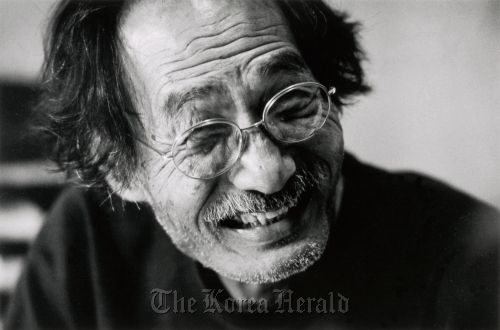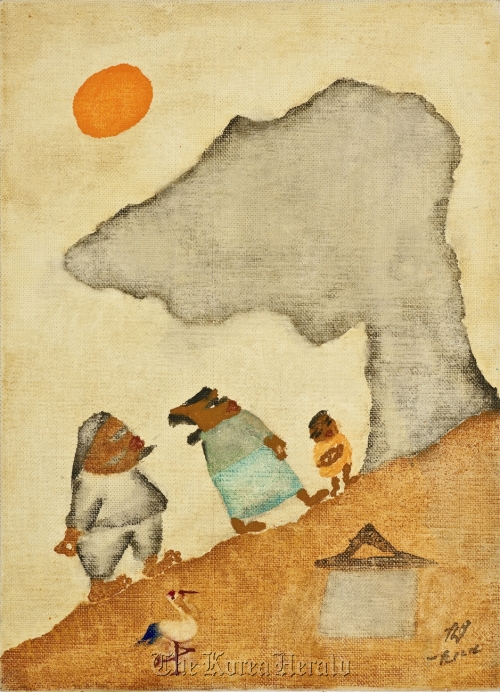Chang’s retrospective exhibition offers simple and heartwarming paintings
By Park Min-youngPublished : Jan. 10, 2011 - 17:08
Having a stable job for eight years ― two years as a researcher at the National Museum of Korea and six as a professor at Seoul National University ― was enough for Chang Ucchin.
Without much hesitation, the freewheeling artist resigned from the respected position and wandered off to the countryside to devote the rest of his life entirely to painting.
He drifted from atelier to atelier that he built in rural areas throughout the country and created paintings that demonstrate ultimate simplicity, a unique style that he later became famous for, and which perfectly reflects his lifestyle as well.
“I’m simple. A frequent utterance of mine. But I now confess with some urgency. I’ve stubbornly demanded a clean life,” Chang had said.
Chang, who was born in 1917 in South Chungcheong Province and died in 1990, is one of the most renowned modern artists in Korea along with Park Soo Keun, Lee Joong-seop and Kim Whan-ki.
To commemorate the 20th anniversary of Chang’s death, Gallery Hyundai and Chang Ucchin Foundation will jointly open the artist’s big-scale retrospective exhibition at Gallery Hyundai in Sagan-dong, central Seoul on Friday.
Without much hesitation, the freewheeling artist resigned from the respected position and wandered off to the countryside to devote the rest of his life entirely to painting.
He drifted from atelier to atelier that he built in rural areas throughout the country and created paintings that demonstrate ultimate simplicity, a unique style that he later became famous for, and which perfectly reflects his lifestyle as well.
“I’m simple. A frequent utterance of mine. But I now confess with some urgency. I’ve stubbornly demanded a clean life,” Chang had said.
Chang, who was born in 1917 in South Chungcheong Province and died in 1990, is one of the most renowned modern artists in Korea along with Park Soo Keun, Lee Joong-seop and Kim Whan-ki.
To commemorate the 20th anniversary of Chang’s death, Gallery Hyundai and Chang Ucchin Foundation will jointly open the artist’s big-scale retrospective exhibition at Gallery Hyundai in Sagan-dong, central Seoul on Friday.

Sponsored by the Ministry of Culture, Sports and Tourism and Jongno-gu, the exhibition will cover the artists’ whole career from the 1940s to 1990. Many museums and collectors readily lent their collections for this monumental show.
Chang’s paintings are simple indeed, reminiscent of those by little children. Chang, however, seemed to have known exactly which buttons to push to move the viewers ― crack them up, send them lost in childhood reminiscence or even have them burst into tears.
In any case, visitors would walk out of the gallery with a heart full of warmth to fight the icy weather after spending some time taking in the artist’s small-sized paintings that depict families, children, animals and rural landscapes.
Among the 60 oil paintings and 10 Chinese ink paintings on display, the work “Self-portrait” from 1951, in particular, reflects Chang’s sense of humor. It features a gentleman in a suit leisurely walking down a golden field of grains, which is actually an ironic expression of the pain and hunger the artist suffered during the Korean War.
The exhibition also displays Chang’s very last work, a sketch of the East Ocean, which is signed Dec. 19, 1990, only ten days before he succumbed to a fatal heart attack. Chang had kept his word that he would “use up all of the body and heart by painting until death.”
“Night and Old Man,” another painting from 1990, was finished two months before his death. In the painting, an old man dressed in white is walking off somewhere in the dark, making today’s viewers wonder if the artist had known that his end was near.
Chang Gyung-soo, Chang’s eldest daughter who is currently a board member of the Chang Ucchin Foundation, told the press last week that she wondered the same thing. The painting was in fact the first thing that came to mind when she heard the news of his death.
“I finally understood the momentary hesitation I felt when I first saw the work,” she said.
Some of the exhibits which are owned by individual collectors, including “Ox” from 1953, “The Half Moon” from 1988, “Tree” from 1988, and “A Family on the Hill” from 1988, will be on view to the public for the first time.

Another notable part of the exhibition will be the reproduction of Chang’s atelier. Some of the actual articles left by Chang in his atelier in Yongin, Gyeonggi Province, will be showcased in the gallery.
An English-language catalogue which introduces 101 of Chang’s paintings and several essays by prominent art figures in Korea including art critic Oh Gwang-su and late historian Choi Sunu has been published in time for the retrospective. Maronie Books, the publishing firm which was in charge of Park Soo Keun’s English catalogue last year, handled the job.
The book-making process was relatively easy in Chang’s case because it could refer to his Catalogue Raisonne, a book covering every known work of an individual artist, of his oil paintings, which was published in 2001.
Thanks to his wife who took a photo of Chang’s every work and numbered them throughout his career and his death, Chang is the only Korean artist who has a book of this kind.
“Chang Ucchin Catalogue Raisonne: Oil Paintings” contains over 720 of Chang’s oil paintings. The book freed Chang from many forgery controversies.
“Some undisclosed works will be unveiled through this exhibition, so we plan to publish an updated catalogue within a couple of years,” said Chang’s daughter.
The exhibition runs from Jan. 14 to Feb. 27 at Gallery Hyundai in Sagan-dong, central Seoul. Tickets are 2,000 won for adolescents and 3,000 for college students and adults. Children unaccompanied by adults are not allowed. The gallery is closed Mondays. For more information, call (02) 2287-3500 or visit www.galleryhyundai.com.
Chang’s works can also be found at Kim Chong Yung Sculpture Museum in Pyeongchang-dong, central Seoul, which is currently holding a special exhibition featuring three Korean modern artists: Kim Chong-yung, Kim Whan-ki and Chang Ucchin until Feb. 11. The museum is closed Mondays. For more information, call (02) 3217-6484 or visit kimchongyung.com.
By Park Min-young (claire@heraldcorp.com)



















![[Today’s K-pop] BTS pop-up event to come to Seoul](http://res.heraldm.com/phpwas/restmb_idxmake.php?idx=642&simg=/content/image/2024/04/17/20240417050734_0.jpg&u=)